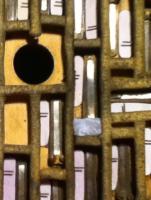Search the Community
Showing results for tags 'thumb button'.
-
I'm continuing this discussion here as a new topic, as it has diverged from the main topic where it started: Troubadour Wicky/Hayden duet under General Concertina Discussion. More, yes, but not entirely. In the left hand, my 59-button Crane has three "extra" notes (i.e., notes not found on a normal 55-button). They are Bb, A, and F below the low C, and all outside the standard 5-across rows. The F and Bb are in an "extra column" to the left of the usual 5 columns of a Crane array, and the A is a thumb button. (The fourth "extra" to make up the 59 is a low B-natural in the right hand, exactly where it belongs by extending the Crane pattern "to rule".) I can "get used to" playing these notes where they are. Heck, I could "get used to" playing a random placement of notes, which is pretty close to what one gets with various more-than-30 button anglos, where virtually no two are alike. But I would be much more comfortable with "reaching" for them if they were where they "fit the pattern", especially if I'm transposing on the fly. Patterns are patterns; exceptions are... "Gotta stop and think." And that's not just about where to find the note(s), but how to construct the fingering. Fingerings have "patterns", too. But getting back to "thumb buttons": My thumbs are neither as quick nor as flexible as my other fingers, so trying to use them in "equal" combination with the others is a hindrance to the general flow. (My "little fingers" are somewhat in between, but that's a separate issue/topic.) Using the thumb to hold down a drone note is a different matter and could even be a convenience, but that "convenience" can only be available in a very limited number of keys. The low A thumb key on my 59-button Crane can be cool if I'm playing in A or D (major or minor) but if I want to play in F and take advantage of my "extra" low F as the base of the bass, the A is not appropriate as a drone, and its position makes the low F chord awkward for my hand. I can see that particular individuals may find particular "out of pattern" notes to be handy in particular tunes or arrangements, but not in general. Evidence of this is the proliferation of attempts to design "better" general layouts. (The Wicki/Hayden is one of the few, and the most recent, that has gained wide popularity.) It's important to ask, "Better for what?" One of my criteria, which I discovered early in my playing of the English system is a pattern that can be extended unambiguously. I.e., I discovered myself without thinking reaching for notes that weren't there on my treble English, but when I got a tenor-treble, they were exactly where I had been reaching for them. I'm curious about what keyboard characteristics others find significant, both from mental (visualizing?) and physiological (finger patterns and shapes) standpoints.
- 2 replies
-
- duet system
- thumb button
-
(and 1 more)
Tagged with:
-
The 'inboard' mounted reeds on the Jeffries 38 system (and presumably the larger Anglos and duets too) have a slightly different tone to those mounted at the side of the reed pan. This problem is most acute on the left side thumb button reeds, where the tone is distinctly nasal in comparison to their 'outboard'cousins. Because of the position of this button's reed chamber, the air hole is drilled through both the pad board and the action plate and is thus twice the depth of all the other holes. In a sudden fit of activity last week, I thought I'd check what a reduction of the reed chamber size might do to the tone, since I'd seen a kind of 'double wall' on the respective chamber of another instrument, and also noticed that the air hole appears to be drilled more towards a position above the middle of the reed than on other notes. Anyway, I made some experiments with modeling clay and found enough of an improvement to be worth mentioning here. The best position seemed to fill the chamber up to, and over the clamping bar of the reed as shown in this picture. I have now replaced my son's modeling clay with a piece of blu-tac which I feel will less likely to stain or damage anything. It should also harden in time and be easier to remove. I've made a couple of very unscientific recordings both with and without the modification, which nevertheless seem to bear out my audible impressions. In both recordings, the thumb button is the middle note of each descending run of three notes and I've recorded both push and pull. Anybody else tried this, or found a different solution for this problem? Adrian.


